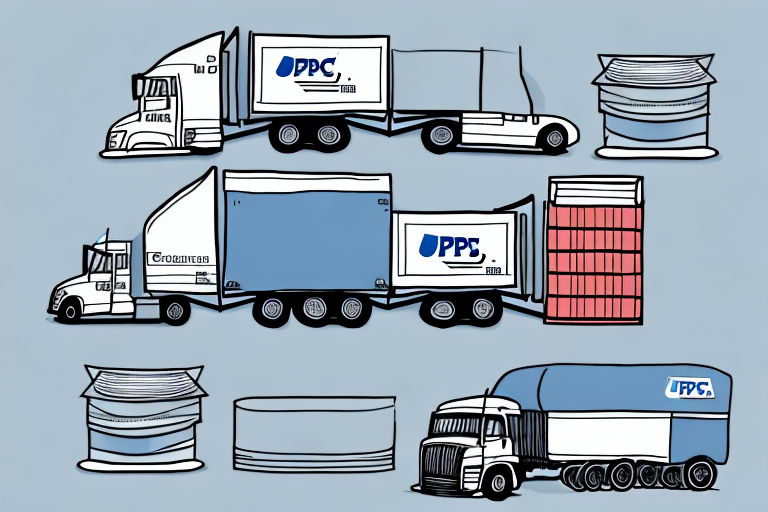Comparing Shipping Rates: UPS vs. USPS
As businesses grow and expand, selecting the right shipping carrier becomes increasingly crucial. The two industry giants, UPS and USPS, each offer unique advantages and disadvantages. This article provides a comprehensive comparison of shipping rates and services between UPS and USPS to help you determine which carrier best suits your business needs.
Introduction: The Significance of Choosing the Right Shipping Carrier
Choosing the appropriate shipping carrier is vital for ensuring reliable and fast delivery while minimizing shipping costs. A suitable carrier can significantly impact business operations, customer satisfaction, and profitability. Factors such as coverage area, delivery speed, customer service, and cost-efficiency must be carefully evaluated to make an informed decision.
One critical factor is the carrier's coverage area. Some carriers may have limited reach in specific regions or countries, potentially causing delays and additional expenses. It's essential to select a carrier that can efficiently deliver to all the locations your business targets.
Another important consideration is the level of customer service provided by the carrier. In case of issues like delays or lost packages, responsive and effective customer support is indispensable. Effective communication and transparency are key to building trust and loyalty with your customers.
The Pros and Cons of Using UPS for Shipping
UPS offers a wide range of shipping services, including ground, air, international, and freight shipping. With a robust presence in the shipping industry, UPS is a reliable choice for many businesses.
Advantages of UPS
- Fast Delivery Times: UPS provides expedited shipping options such as next-day and two-day delivery, ensuring timely deliveries.
- Extensive Tracking Tools: UPS offers real-time tracking features that allow businesses and customers to monitor packages at every stage.
- Reliable Customer Support: UPS is known for its dependable customer service, providing assistance through various channels.
- Comprehensive Services: From freight to international shipping, UPS caters to diverse shipping needs.
Disadvantages of UPS
- Higher Shipping Rates: UPS tends to have higher rates, especially for small businesses and residential deliveries.
- Strict Package Restrictions: UPS enforces strict size and weight limits, which may result in additional fees or the need to use alternative carriers for oversized packages.
- Occasional Issues with Package Handling: While rare, some customers have reported instances of lost or damaged packages.
The Pros and Cons of Using USPS for Shipping
The United States Postal Service (USPS) is a government-run carrier offering priority, first-class, and international mail services. It often serves as a more affordable alternative to UPS.
Advantages of USPS
- Lower Shipping Rates: USPS generally offers more affordable rates, particularly for small and lightweight packages.
- Flat-Rate Shipping Options: Flat-rate boxes provide predictable shipping costs regardless of package weight or destination.
- Extensive Network: With a vast network of post offices and mailboxes, USPS makes dropping off packages convenient.
- Variety of Shipping Options: Services like Priority Mail, Overnight Delivery, and Saturday Delivery cater to urgent shipping needs.
Disadvantages of USPS
- Limited Tracking: Tracking capabilities are more restricted compared to UPS, especially for standard mail.
- Potential Delays: USPS may experience delays during peak shipping seasons, such as holidays.
- Less Comprehensive International Services: While USPS offers international shipping, it may not match the speed and reliability of UPS for certain destinations.
Comparison of Shipping Rates: UPS vs. USPS
Shipping rates between UPS and USPS vary based on factors like destination, package weight, and distance. Generally, UPS charges higher rates for small businesses and residential deliveries, while USPS offers more competitive rates for these shipments. However, for larger packages or international shipping, UPS may provide more favorable pricing.
Data Insight: According to the 2023 Shipping Rate Analysis Report, USPS offers up to 25% lower rates for parcels under 5 pounds compared to UPS.
Another consideration is delivery speed. UPS offers a variety of expedited delivery options, which are typically more expensive than USPS's standard services. However, if rapid delivery is essential, UPS might be the preferable choice. USPS’s Priority Mail provides faster delivery than standard services but may not match UPS's expedited reliability.
Regarding package tracking, UPS provides real-time tracking for all packages, offering detailed insights throughout the shipping process. In contrast, USPS only offers tracking for select services, which might limit visibility for some shipments.
Factors That Affect Shipping Rates for Both Carriers
Shipping rates for both UPS and USPS are influenced by several factors, including:
- Package Weight and Dimensions: Heavier and larger packages incur higher shipping fees.
- Shipping Distance: Longer distances typically result in increased shipping costs.
- Delivery Speed: Faster delivery options come at a premium.
- Delivery Location: Residential deliveries may be priced differently than commercial deliveries.
- Special Handling Requirements: Items requiring special handling, such as fragile or hazardous materials, may attract additional fees.
Additionally, both carriers offer discounts for bulk shipments and businesses with high shipping volumes, which can significantly reduce overall costs.
Tracking Services Offered by UPS and USPS
Effective tracking services are essential for monitoring package status and ensuring timely deliveries.
UPS Tracking Services
- Real-Time Tracking: UPS provides detailed real-time tracking for all shipments, accessible via their online portal and mobile app.
- Quantum View: A premium service offering advanced tracking features and customizable alerts for businesses with high shipping volumes.
USPS Tracking Services
- Standard Tracking: Available for Priority Mail and packages with additional services, offering basic tracking information.
- Informed Delivery: Allows customers to preview images of incoming mail and packages, providing enhanced visibility.
Source: [USPS Informed Delivery](https://www.usps.com/informed-delivery/) and [UPS Quantum View](https://www.ups.com/us/en/services/quantum-view.page)
Shipping Speeds: How Fast Can You Expect Your Delivery?
Both UPS and USPS offer a range of delivery speeds to accommodate different business needs.
UPS Shipping Speeds
- Next-Day Air: Guarantees next-business-day delivery by specific times.
- 2nd Day Air: Delivers within two business days.
- Ground Shipping: Offers cost-effective shipping with delivery typically within 1-5 business days.
USPS Shipping Speeds
- Priority Mail Express: Provides overnight delivery to most U.S. locations.
- Priority Mail: Delivers within 1-3 business days.
- First-Class Mail: Suitable for lightweight packages, usually delivered within 1-5 business days.
Delivery speeds may be affected by factors such as destination, seasonal demand, and package size. During peak periods, both carriers may experience delays, so it's advisable to plan accordingly and utilize tracking tools to monitor shipment progress.
Delivery Guarantees: Which Carrier Offers Better Protection?
Both UPS and USPS provide delivery guarantees to ensure timely and accurate deliveries, though their offerings differ.
UPS Delivery Guarantees
- Guaranteed Delivery Times: For expedited services like Next-Day Air, UPS guarantees delivery by a specific time.
- Refund Policy: If UPS fails to meet the guaranteed delivery time, customers are eligible for a refund.
USPS Delivery Guarantees
- Express Mail Guarantee: USPS guarantees overnight delivery with a money-back guarantee if the service fails to meet the timeframe.
- No Guarantee for Standard Services: Regular Priority and First-Class Mail do not come with delivery time guarantees.
Cost Considerations: UPS's delivery guarantees are included with their expedited services, which come at a premium cost. USPS includes delivery guarantees with their Express Mail services, which are also priced higher than standard options.
International Shipping: A Comparison Between UPS and USPS
International shipping involves navigating various regulations and customs requirements, making the choice of carrier even more critical.
UPS International Shipping
- Extensive Global Coverage: UPS serves over 220 countries and territories, offering reliable international shipping options.
- Faster Transit Times: UPS typically provides quicker delivery times for international shipments compared to USPS.
- Comprehensive Services: Offers air and ocean freight, customs brokerage, and international trade management.
USPS International Shipping
- Cost-Effective Options: USPS provides more affordable international shipping rates, especially for lightweight packages.
- Variety of Services: Includes Priority Mail International, First-Class Mail International, and Global Express Guaranteed.
- Limited Tracking: Tracking capabilities may be less comprehensive outside the U.S.
Regulatory Considerations: Certain countries impose specific restrictions. For example, shipping to Cuba is only available through USPS due to U.S. trade restrictions. UPS may require additional documentation and fees for destinations like Brazil and Russia.
Customer Support: UPS offers more personalized support for international shipments, whereas USPS's support for international services may be more limited.
Customer Service Comparison: Which Carrier Offers Better Support?
Effective customer support is essential for resolving shipping issues and maintaining smooth operations.
UPS Customer Support
- Reliable Support Channels: Offers phone, email, and live chat support for immediate assistance.
- Comprehensive Online Resources: Features an extensive online support center with FAQs, tracking tools, and live chat options.
USPS Customer Support
- Support Services: Provides phone and email support, though customers may experience longer wait times.
- Online Resources: Offers an online support center with FAQs and shipment tracking, though it may be less user-friendly compared to UPS.
Customer Satisfaction: According to the 2023 Customer Service Survey, UPS ranks higher in customer satisfaction for support responsiveness compared to USPS.
Additional Services Offered by Both Carriers
Beyond standard shipping, UPS and USPS provide a variety of additional services to enhance the shipping experience.
UPS Additional Services
- Pickup and Drop-off: Offers scheduled pickups and numerous drop-off locations for convenience.
- Packaging Supplies: Provides a range of packaging materials to ensure safe shipments.
- Insurance: Offers shipping insurance to protect valuable or fragile items.
- Brokerage and Fulfillment Services: Assists businesses with customs brokerage and order fulfillment for international and domestic shipments.
USPS Additional Services
- PO Boxes and Mail Forwarding: Provides PO box rentals and mail forwarding services for secure and convenient mail management.
- Packaging Supplies: Supplies a variety of packaging options tailored to different shipping needs.
- Insurance: Offers limited insurance options for registered and certified mail services.
Both carriers also offer comprehensive international shipping solutions, allowing businesses to reach global markets efficiently.
Conclusion: Choosing the Right Carrier for Your Business's Shipping Needs
Deciding between UPS and USPS depends on several factors, including your business's shipping requirements, budget, and customer expectations.
- Choose UPS if:
- You require faster shipping times and reliable expedited services.
- Advanced tracking and comprehensive customer support are priorities.
- You handle larger or international shipments regularly.
- Choose USPS if:
- Cost-effectiveness and predictable shipping rates are essential.
- You primarily ship lightweight and non-fragile items.
- You need extensive domestic coverage with convenient drop-off options.
Additionally, consider the nature of the products you are shipping. For fragile or high-value items, UPS's secure packaging and reliable handling may be advantageous. For domestic shipments, especially within the United States, USPS offers a more affordable and convenient option.
Ultimately, the best choice depends on a thorough analysis of your specific shipping needs and business goals. Evaluating factors such as shipping volume, destination, package characteristics, and required delivery speed will guide you in selecting the most suitable carrier.
For more insights on shipping carriers, visit our detailed comparison reports at ShipScience.




















